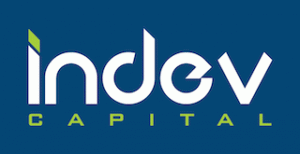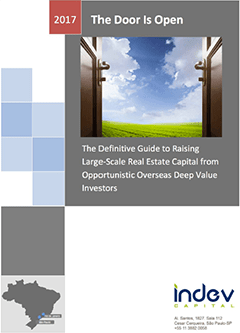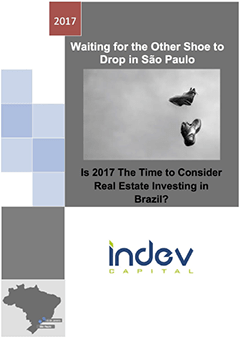
A Guide to Create Value through Residential Developer Distress
The objective of this document is to provide institutional real estate investors a framework to invest in the distressed real estate market in Brazil and achieve high risk-adjusted returns at this time in the real estate cycle. It will be helpful to understand this document if you read an earlier newsletter comparing Commercial vs. Residential Distress Opportunities (please click here or email the author at joseph.williams@indevcapital.com for a copy). The focus of this document is Distressed Residential Real Estate Opportunities, particularly investments that take advantage of middle market developer distress with a focus on urban infill middle- and upper-middle-income residential apartment projects in Sao Paulo. This is where distress opportunities are happening now, and where investors can find the deepest discounts and the highest risk-adjusted returns in 2016.
In an effort to provide an overview of the distressed investment process, this document will provide information and an analysis of the following: 1) the Sao Paulo residential market history and size; 2) the current situation and the opportunity with middle market developers; 3) investor negotiation strategies for distressed investing in Brazil in comparison with developer negotiation strategies; 4) replacement costs analysis, 5) zoning with specific information of how it restricts supply in some cases; 6) comparable project analysis; 7) acquisition strategy; 8) deal structure; and 9) market recovery sales strategy.
To our knowledge, it is the first document of its kind and we hope that it is helpful. InDev is always open to learning and improving. We consider this a living document and look forward to your feedback. Finally, we will be in NYC in late March / early April with a well-capitalized Brazilian sponsor who would like to JV with an equity partner in buying distressed residential properties. We welcome a meeting to discuss these opportunities face to face.
Background of the São Paulo Residential Real Estate Market: Strong, Large, and Diversified, with a Price Floor Even Now
2016 will offer distressed residential investment opportunities in Brazil. This document will have a strong bias towards the Sao Paulo middle- and upper-middle-income market. Our bias is not because there are not distressed opportunities outside of the Sao Paulo metropolitan area. To the contrary, there are many and perhaps even deeper distressed opportunities outside of Sao Paulo. However, it is our opinion that no other market in Brazil has the depth, top tier assets, and, most importantly, the resiliency to come back as fast as middle- and upper-middle-income residential apartments in Sao Paulo when the market recovers. Why?
In the USA, a young ambitious person can choose from several cities to start their career, or a mid career person can move to one of several different cities to make a career advancement. For example, San Francisco, Boston, Chicago, etc. offer close to equal if not better opportunities in some fields than NYC. In addition, although readers of this document based in NYC (the large majority) may feel differently, these other top-tier cities in the USA offer cultural events, nightlife, peer networks, secondary educational opportunities, concentration of intellectual talent, corporate career opportunities, college education, and concentration of decision makers equal to NYC (I hope that by saying this I keep my Upper East Side NYC friends!).
This is not the case in Brazil. To a large extent, it is fair to imagine Sao Paulo as the NYC, SF, Boston, and Chicago of Brazil with Rio as the Los Angeles and Brasilia as the Washington, DC. There is a significant concentration of business enterprises and wealth in Sao Paulo. For example, Sao Paulo city alone represents 11% of GNP while only representing roughly 5.5% (11,967,825 population 2014) of Brazil’s population. The Sao Paulo metropolitan area is 18% of GNP while only representing roughly 10% (20,284,891 population 2014) of the population (IBGE, 2013). It is hard to overstate the importance of the city of Sao Paulo to Brazil’s economy.
Metropolitan Sao Paulo, Brazil – Fact Sheet

Due to Sao Paulo’s size, values on family formation (71,752 marriages in 2014) (IBGE, 2014) , and the fact that it is the undisputed business center in the country, even with the worst financial crisis in recent memory, the core demand for residential housing in the city is over 18,000 units per year(Secovi, Sao Paulo equivalent of National Association of Homebuilders). This level of core demand even in a very, very tough environment bodes well during a recovery period.
São Paulo Residential Real Estate
Units Sold – São Paulo city
Average 2006-2013= 32,3 thousand

Source: EMBRAESP (Thousand Units)
Nominal Price Variation in Red (%) and Real Variation Factored for Inflation in Blue (%) Year-Over-Year

Source: EMPRAESP (Thousand Units)
Sales and Launches – New Residential Units


Source: SECOVI-SP (Equivalent to the Homebuilder’s Association of Sao Paulo), EMBRAESP
(Thousand Units)
Inventory – New, Unsold Residential Units

Source: SECOVI-SP (Thousand Units)
As the above data shows, there was significant growth in both supply and demand from 2006 to 2013. There were several important factors that led to this growth.
Latent demand – Until 2006 there was no significant long-term mortgage financing for individuals. Therefore, only the upper class could purchase apartment units. Construction financing was mostly done through pre-sales as there was little bank financing to finance construction.
Strong Net Family Formation in Sao Paulo – Per the earlier cited marriage statistics, there are a significant number of families that are created in Sao Paulo on a yearly basis. Also, due to net positive migration of young ambitious people into Sao Paulo, this number will likely remain stable if not grow.
Expansion of Credit – From 2006 to 2013 there was significant expansion of credit in Brazil. In addition, due to the high demand, banks were lenient by Brazilian standards with construction loans. For example, a developer could receive financing for 80% of construction costs upon selling 20% of the units under contract and completing 10% of the construction. Finally, due to government intervention in the economy, interest rates hit a record low in Brazil of 7.25% in 2013 (Central Bank of Brazil), which significantly lowered the costs of working capital for companies.


Source: ABECIP (Brazilian Credit Association)
Zoning and Price per Square Meter
The Zoning Code in Sao Paulo became much more restrictive in 2004. Before 2004, with the purchase of a 1000m2 land site, a developer could build 4000m2 of sellable area. In 2004, the developer was only able to build 2000m2 of sellable area. However, he could purchase air rights. The price of these air rights effectively doubled the price of the land per square meter. A similar zoning change happened in 2014. For projects approved after 2014, on a 1000m2 land site, the developer can only build 1000m2 and then purchase air rights. This will restrict supply and cause prices to rise even higher when the market recovers.
Core Demand and Distressed Opportunity
As noted earlier, it is very important to note that even in the worst economy in recent Brazilian history, in the city of Sao Paulo there is strong core demand of 18,000 units per year. This core demand provides a floor to the market. Sao Paulo’s new zoning code passed in 2014 restricts and increases the costs of sellable area, and low equity and debt capital available for developers greatly limits new product launches in the medium term. This combination creates a window of opportunity for investors with the right local sponsor purchasing the right assets in the right locations. This is the core of the investment thesis.
Why Start to Look at Brazil Now?
There are severe economic and political crises occurring simultaneously. These crises have paralyzed the critical fiscal adjustments necessary for the economy to return to growth. So as a real estate investor, why start to look at Brazil now?
Blackstone and Brookfield Commercial Acquisition
Blackstone and Brookfield purchased a combined R$3.14B of commercial real estate in 2015, respectively. At the time, many questioned whether the bottom of the market had occurred at the time of these purchases. Importantly, Blackstone and Brookfield purchased assets from the largest and most successful commercial real estate company in Brazil, BR Properties. The properties purchased were top tier assets, most in prime locations, and purchased at attractive although not rock-bottom pricing. Blackstone and Brookfield’s distressed investing strategy was that it was important to buy the best assets in the best locations from the best developer or sponsor. Blackstone and Brookfield believed that those who waited for the bottom perhaps may find cheaper assets but those assets will not be the best locations nor assets that will likely have the most value as the economy improves.
Why Now for Residential Real Estate?
As an investor looks at the residential space, there are similar aspects to Blackstone’s and Brookfield’s analysis in commercial real estate, with a key difference. There is real distress in residential because residential developers borrowed large amounts of debt! Debt does not and has not existed in commercial real estate in Brazil (please click here for a newsletter that discusses this in detail). Currently, top residential developers are afraid, banks have started to tighten credit and call in loans, developers are facing lower pre-sales, and top-tier assets and land sites in top-tier, solid middle-class neighborhoods are currently available at significant discounts from developers.
The moment that residential developers with top assets in the top locations feel that the market is firming, they will not sell to distressed investors and will begin to sell units to either angel investors who will quickly return with confidence, or the developer will simply hold on for better times. These top tier assets will be the first to leave the market. The remaining distress investment opportunities will be of lesser quality. Not only will these assets in sub-prime locations benefit less from the recovery due to greater developer confidence, but investors’ negotiating leverage will be less. Currently, the best residential assets in the best locations can be purchased with maximum negotiating leverage. These assets will no longer be available as soon as there is the first sign of stability.
2016 is Different from 2015
In 2016, the local market recognizes that this distress is real and there is almost no capital found locally. In 2015, Brazilian developers had not quite accepted the situation, and many were actually hopeful of a quicker recovery and wanted to hold out for better times. Now there is a mood of fear and capitulation that the economy and the political crisis will not be getting better any time soon. This creates a much better negotiating position for buyers than in 2015.
Banks are Tightening Aggressively
Banks are pulling back aggressively. A well-capitalized developer client of InDev had the interest rate offer for a construction loan change from 10% to 17% overnight. The client is very well-capitalized and was able to finance the development himself and move forward with the project. However, this is not the case for most developers. The best opportunities often occur in this type of environment. Bank pressure creates motivated sellers even in Brazil!
Impeachment Process
The current leftist government currently has an all-time low approval rating among all social classes. Moreover, the largest company in Brazil in terms of revenue, Petrobras, is in the middle of a corruption scandal of epic proportions and significant impact on the economy. The combination of China’s economic slowdown and several very bad decisions by the current government has created the crisis. However, the simultaneous political crisis has created very negative consumer sentiment, particularly among the upper-middle class.
For institutional investors the possible impeachment is a very interesting opportunity. The situation is extremely dynamic; however, what is clear is that the political situation is approaching a turning point. Investors have a unique advantage in this situation. Why? If Dilma is impeached, initially there will be huge optimism in the market. This emotion will be strong but fleeting. After the celebration, developers will recognize that their balance sheets have not changed due to Dilma’s impeachment and interest rates will take time to reduce to “normal” levels. Therefore, developer distress will still exist and investors will have more clarity on a window for a recovery.
Current Situation Impact of Crisis – The Other Shoe is Dropping and Some Developers Are Approaching Capitulation
Banks have tightened lending requirements.
Residential Mortgages – Mortgage rates have increased from 8.7% annually (June 2014) to 10,4% annually (Nov. 2015) (This data is according to Brazil’s Central bank and is the average of the five largest private banks in Brazil. It excludes an index called TR which was .85% per year in 2014 and 1.79% in 2015). Moreover, the down payment required has increased from 20% to 30% of the value of the unit. This increase in interest rates combined with an increase in down payment has a direct impact on affordability.
Construction Financing – Earlier in the cycle, banks financed construction based upon the developer achievement of pre sales of 20% of the units and constructing 10% of the residential tower. Upon achieving these levels, the bank would fund 80% of the cost of construction. Currently, the developer must achieve pre-sales of 40% to 50% of the units and construct 20% of the residential tower to receive 80% construction financing. This is very difficult for the developer to achieve in this stage of the real estate cycle.
Corporate Credit and Working Capital – Corporate credit rates, never inexpensive in Brazil, have perhaps seen the largest increase. Although the rates vary by company, there is severe restriction of credit occurring that is squeezing balance sheets.
Consumer Sentiment – Letting Apartments Go – Due to the lack of credit for the buyer and the current employment environment, many buyers that signed purchase contracts and have made payments (deposit installments) for two years during a unit’s construction, now either cannot or basically are refusing to take the mortgage upon delivery of the keys. Why? This group of buyers has lost confidence in their employment prospects, the bank financing costs have become much larger than expected, or worse yet, buyers may have lost their jobs.
Equity Shortage – Along with the demand side reduction, sales speeds have slowed and there are less pre-sales deposits per unit (in the olden days, buyers of high-end units would sometimes pay 50% or more during construction), there are far fewer angel investors interested in investing at the pre-sales level to fund construction.
The Opportunity
Many middle market developers started projects on very good sites in 2013 and 2014. Some of these projects are in great locations and have great prospects in a stable (non-contracting) economy with a more predictable political environment. Currently, the coveted buyers with cash are either working to negotiate a large discount or are waiting for the price to go lower based on the impeachment process, etc. Due to this situation, some developers are not able to hold on to the projects and will have to sell units at a large discount early to continue to build, finish the project, and try to recover the best they can from a bad situation.
Pressure on the Developer
1. Corporate Debt – Cost is increasing and pressure from banks is increasing daily
2. No Capital to Finish the Project – The developer cannot stop a project once it starts; they have to keep the engine moving
3. Bank Financing Limited – Some projects started without bank financing depended on rapid pre-sales (not unusual for high-end projects in Brazil as these buyers often paid 50% or more before construction completion in earlier times)
4. The pre-sales did not happen and now the developer is in distress
5. Buyer Reluctance – Buyers with cash can wait and play the market, no rush to purchase
6. Buyer Budget – Buyers without the resources simply cannot make a transaction work
The Perfect Negative Storm Has Developed for Middle Market Developers
Negotiating Position
Early in the developer’s realization that the development firm is in distress, an attempt is made to sell limited units at the highest possible price to an investor in order to use the in-coming capital to finish the project. This strategy is currently difficult as there are few large capital sources available. Developers are becoming more and more aware that it is an investor’s market.
If a project has already started, even if the pre-sales are below expectations, the developer must finish the project. The developer is aware that when the market recovers, if the product is not available and complete, then the window of opportunity to sell and receive cash that is so needed to fix the balance sheet and keep the engine moving closes. It is very difficult for the developer to stop the process.
Developers’ negotiating objective – InDev’s perspective
a. Attempt to sell based on a discount from the Tabela (sales table) – Show huge discount
b. Use a large discount as the starting point of negotiation, attempt to use “market price” as starting point
c. Provide a preferred return to the Investor
d. Sell as few units to investors as possible and try to sell developer-retained units first as that will provide the most profit
e. Use investor cash to finish project (ideal for investor) or pay down corporate debt (not ideal for investor)
f. Maintain liquidity and the business engine (no need to lay off good people)
Investor’s desire – InDev’s perspective
a. Only buy at or below replacement costs, not one nickel more and hopefully less
b. Local sponsor investor to assist with analysis and “feel” of the market
c. Best middle- and upper-middle-income neighborhoods provide downside protection and likely fastest recovery
d. Returns need to justify risk – significant preferred return
e. Buyer’s market, not a seller’s market
f. Alignment of interests, developer must sell investor units before selling developer units
Acquisition Strategy, or, How to Avoid Buying a Cheap Pile of Trash
In 2015, smart investors made large purchases of public developers’ distressed residential real estate inventory at significant discounts. There was, and still is, a SIGNIFICANT supply of what the author will kindly call “sub-optimal product” or what is otherwise known as in eastern North Carolina as simply “trash”.
The investor acquisition strategy in today’s market needs to include the following steps: 1) neighborhood analysis; 2) product analysis; 3) replacement costs analysis; 4) zoning analysis; 5) developer analysis; 6) comparable projects; 7) distress analysis; 8) correct approach and negotiating strategy; 9) deal structure; and 10) most importantly- a local JV sponsor!
Neighborhood Analysis
Certain neighborhoods of Sao Paulo are aspirational for those who are looking to move up in the world and are simply the must-have addresses for those that are already in the upper class. These neighborhoods tend to be centrally located and have amenities that upper-income families desire.
In addition, there are the neighborhoods which are one level down on the income strata which have the same characteristics desired by upper-income communities (close to work, good schools, and amenities) and are solid middle-income communities.
In both cases, the target neighborhoods: 1) need to have a large percentage of the population that has an aspirational desire to live in the neighborhood upon achieving the required level of income or 2) are already consolidated neighborhoods with long-standing residents and families that have lived, and will continue to live, in this area.
Product Analysis
Product analysis is more complicated than usual because of the effect of the new Zoning Code which creates unique opportunities for projects previously approved under the old Zoning Code. In addition, certain projects may require changes based on incorrect project analysis by the previous developer in a market that has changed. The product needs to match the current and near-future market demand and this will require a local sponsor. In particular, design aspects need to be considered for high-end locations with restricted new supply coming onboard.
Replacement Costs Analysis
This is an area where we suggest investors spend some quality time. The three costs are: 1) the land costs and importantly the cost per square meter of net sellable area; 2) construction costs; 3) development costs. It is important to measure the costs of the net sellable area and factor swaps, trades of cash for units or air rights, as an investor calculates the total costs per square meter to replace the unit. These replacement costs are the foundation of the analysis, and a local sponsor is important to verify one’s analysis. The analysis is not complicated but detailed. If more information or a sample financial model is desired, please email me at joseph.williams@indevcapital.com and InDev would be glad to help an interested investor understand the details of this key issue.
Zoning Analysis
Along with replacement costs, it is crucial to understand how the new Zoning Code affects the potential project or investment. InDev has published a newsletter (click here), that covers Sao Paulo’s new Zoning Code in detail. Projects that are in high-income locations and distant (defined by the Zoning Code) from a Metro or Traffic Corridor and were approved under the old Zoning Code have a significant advantage going forward. These projects will face low competition because you cannot build in those regions at a scale that allows a developer to make a profit. New supply is severely limited in regions that are far from the central corridors of public transportation but still in top-tier locations.
If the projects are close to a metro or bus corridor, developers can build to a larger construction coefficient and can add mixed use with no reduction in gross residential sellable area. Developers can build similar projects in these areas; however, due to the restricted supply of profitable land for developers to build on, the pricing in the corridors will increase due the limited supply of land. Again, we have a detailed newsletter that covers zoning. (Please click here for that newsletter)
(If more information is desired about zoning beyond the newsletter, please email me at joseph.williams@indevcapital.com and InDev would be glad to help an interested investor understand Sao Paulo’s zoning in more detail).
Developer Analysis
A key question is whether the developer from which the investor is purchasing units has the capability to last through the downturn. Some developers may not make it through the down cycle. On this point in particular, we suggest partnering with a local operator/investor, as that party will have greater clarity as to which developers are likely just in a tough situation and will likely survive and which developers are in a situation that likely ends in the developer’s failure. Importantly, a local sponsor needs to have the capability to take over the project if necessary.
Comparable Projects
It is important to analyze a radius of 1km for all competing projects that have been launched or likely to come onboard. Along with the characteristics of competing projects, it is valuable to understand how many units have sold, at what price they were sold, and what is the current inventory level of competing projects? Moreover, it is important to know if the developer is public or private. A public developer is more likely to “burn the market”, basically lowering the price to the lowest possible level just to generate cash. Private developers usually are more cautious in this regard, as their cost of capital is higher and they are less likely to “burn” the market, or to sell at any price in order to increase working capital.
Negotiating Strategy Starting Point Offer
The investor who follows the strategy in this newsletter will approach only the best sites in top-tier middle- and upper-middle-income locations. Therefore, the investor needs to arrive at the negotiating table with detailed information and a firm initial purchase price in mind, based on replacement cost. Investor preparation will include replacement costs analysis, market comparisons, and an understanding of how zoning is affecting supply. Avoid conversations with developers who start with discounts from market price and Tabela de Vendas. The investor should only begin the negotiations with an anchor on replacement costs.
Deal Structure
The deal structure of the acquisitions will be decided on a case-by-case basis. If an investor partners with a successful local sponsor with sales, development, and construction capabilities, the investor’s negotiating leverage is significantly greater. In some cases, the entire project will be purchased at a fixed price (replacement cost or below). In other situations, with highly-unique land sites or projects, the investor may offer some upside upon (future) success of the project to the seller in order to close a transaction rapidly.
Sales Strategy Post Market Recovery
The sales strategy, and much of the success of investing in Sao Paulo’s distressed residential real estate opportunity, will largely depend on the local sponsor / co-investor partner. There are certain actions that only a local sponsor with deep experience and vertical integration will have the ability to execute.
For example, due to supply constriction caused by zoning in middle- and upper-middle-income areas and the lack of capital for new projects, the best strategy to maximize revenue and profits may be to design and build larger apartment units. For example, the São Paulo market has very few four-bedroom units that are under new construction. Therefore, an upper-income person with a large family or simply a successful executive that wants more space has few new unit options in some key neighborhoods. Zoning restrictions could make this product a key profit-maker.
Another example of how a local partner can be helpful is a complete change of the product. For example, some developers have developed a very significant strategy of building studio units of very small size. If the investor buys sites from one of these developers, and if some of their sites are in great locations, it is likely a good idea to change the product, even to re-launch a product, as the market has not responded well to this type of product.
Summary
Thanks for reading this guide to investing in Brazilian distressed residential real estate. InDev sent this to you specifically because we thought you would find it of interest. Its goal was to provide a framework to start the process of evaluating the market. We strongly suggest working with an experienced local, vertically-integrated partner, as the nuances of success are not easy and there is a significant advantage to having knowledge on the local market.
If you are interested in learning more email me joseph.williams@indevcapital.com. We hope the document was helpful.
Warm Regards,

Joseph W. Williams
CEO & Founder InDev Capital




